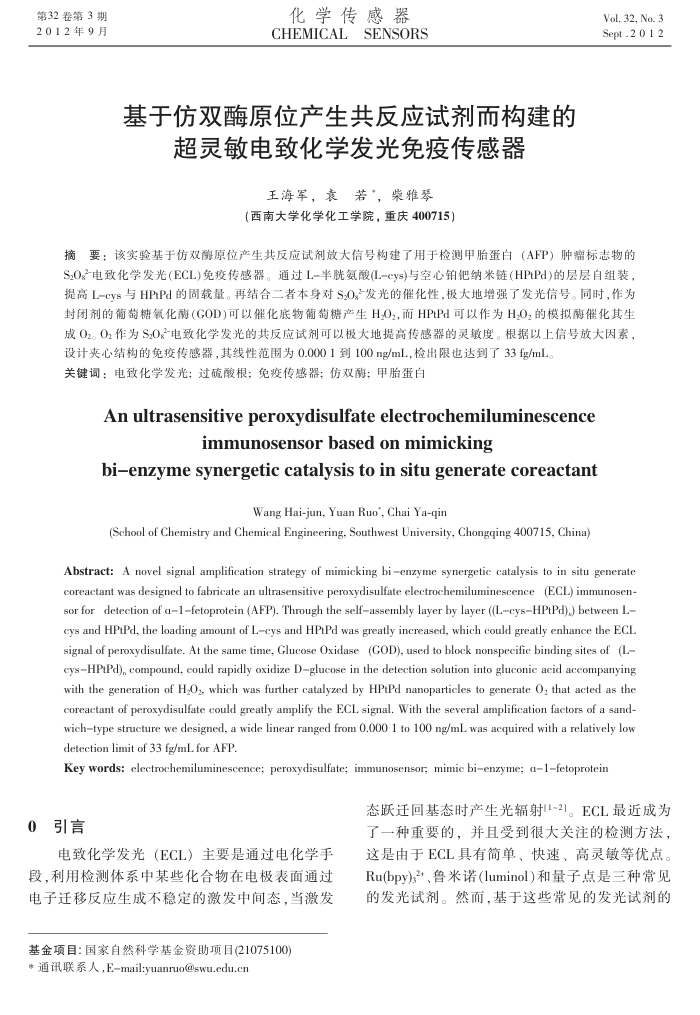基于仿双酶原位产生共反应试剂而构建的超灵敏电致化学发光免疫传感器
内容简介
 第32卷第3期 2012年9月
第32卷第3期 2012年9月化学传感器 CHEMICALSENSORS
基于仿双酶原位产生共反应试剂而构建的
超灵敏电致化学发光免疫传感器
王海军,衰若*,柴雅琴
(西南大学化学化工学院,重庆400715)
Vol.32, No. 3 Sept .2 012
摘要:该实验基于仿双酶原位产生共反应试剂放大信号构建了用于检测甲胎蛋白(AFP)肿瘤标志物的 S2O:-电致化学发光(ECL)免疫传感器。通过L-半胱氨酸(L-cys)与空心铂钯纳米链(HPtPd)的层层自组装,提高L-cVs与HPtPd的固载量。再结合二者本身对SO发光的催化性,极大地增强了发光信号。同时,作为封闭剂的葡萄糖氧化酶(GOD)可以催化底物葡萄糖产生HO2而HPtPd可以作为H,O2的模拟酶催化其生成02。O2作为S20电致化学发光的共反应试剂可以极大地提高传感器的灵敏度。根据以上信号放大因素,
0000 关键词:电致化学发光;过硫酸根;免疫传感器;仿双酶;甲胎蛋白
Anultrasensitiveperoxydisulfateelectrochemiluminescence
immunosensor based on mimicking
bi-enzymesynergeticcatalysistoinsitugeneratecoreactant
Wang Hai-jun, Yuan Ruo', Chai Ya-qin
(School of Chemistry and Chemical Engineering, Southwest University, Chongqing 400715, China)
Abstract: A novel signal amplification strategy of mimicking bienzyme synergetic catalysis to in situ generate coreactant was designed to fabricate an ultrasensitive peroxydisulfate electrochemiluminescence (ECL) immunosen-sor for detection of α1fetoprotein (AFP). Through the selfassembly layer by layer (LcysHPtPd).) between L-cys and HPtPd, the loading amount of Lcys and HPtPd was greatly increased, which could greatly enhance the ECL signal of peroxydisulfate. At the same time, Glucose Oxidase (GOD), used to block nonspecific binding sites of (L cysHPtPd), compound, could rapidly oxidize Dglucose in the detection solution into gluconic acid accompanying with the generation of H,Oz, which was further catalyzed by HPtPd nanoparticles to generate O, that acted as the coreactant of peroxydisulfate could greatly amplify the ECL signal. With the several amplification factors of a sand-wichtype structure we designed, a wide linear ranged from O.000 1 to 100 ng/mL was acquired with a relatively low detection limit of 33 fg/mL for AFP.
Key words: electrochemiluminescence; peroxydisulfate; immunosensor, mimic bienzyme; a1fetoprotein
0引言
电致化学发光(ECL)主要是通过电化学手
段,利用检测体系中某些化合物在电极表面通过电子迁移反应生成不稳定的激发中间态,当激发
基金项目:国家自然科学基金资助项目(21075100) 通讯联系人,E-mail:yuanruo@swu.edu.cn
态跃迁回基态时产生光辐射[1~2]。ECL最近成为了一种重要的,并且受到很大关注的检测方法,这是由于ECL具有简单、快速、高灵敏等优点。 Ru(bpy)2+、鲁米诺(luminol)和量子点是三种常见的发光试剂。然而,基于这些常见的发光试剂的
上一章:压电生物传感器及其信号放大技术
下一章:声表面波阵列传感器研究进展